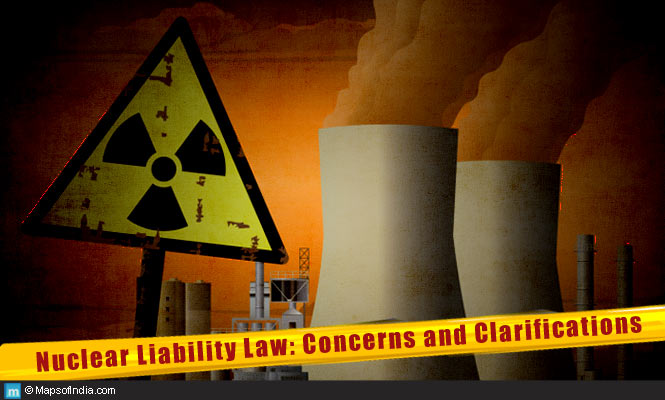 The Civil Liability for Nuclear Damage Act, 2010 (CLND) was enacted after much debate in the Parliament on 25 August, 2010 and the bill came into force on 11 November, 2011. With this Act, India became a member of the International Convention in the civil nuclear arena.
The Civil Liability for Nuclear Damage Act, 2010 (CLND) was enacted after much debate in the Parliament on 25 August, 2010 and the bill came into force on 11 November, 2011. With this Act, India became a member of the International Convention in the civil nuclear arena.
So why has this Act witnessed such fierce debate in the parliament and so much opposition not just from political parties but also the members of civil society?
Background
The opposition to this Act must be seen in the backdrop of two events. One, the infamous Bhopal Gas Tragedy in 1984 and the Indo-US Civil Nuclear Agreement in 2008.
The leakage of deadly gas, Methyl Isocynate (MIC) along with other hazardous chemicals from the Union Carbide pesticide plant in Bhopal led to deaths and permanent and temporary disabilities. The victims had to undergo a long legal battle for compensation, which was too little and too late.
The 1986 Chernobyl disaster in the Russia and the accident at the Fukushima Nuclear Power Plant in 2011 are widely referred incidents whenever the world discusses safety of nuclear plants. The subject has triggered much debate, both in India and overseas. In India, the debate has been on two fronts – Should India promote the use of nuclear energy, given its potential risks? What should be the terms of accountability and liability for compensation, should an incident occur?
Leading private manufacturers of nuclear reactors such as General Electric and Westinghouse, had initially shown interest in building nuclear plants in India but the onus of compensation placed on the supplier made them wilt. The nuclear lobby has been pressurizing the US government to get India to open up its market and address their concerns.
India had been denied nuclear technology by developed nations, led by the US, after India conducted its first nuclear test in 1974 and the second one in 1998. On 10 October, 2008, after intense negotiations, the United States-India Nuclear Cooperation Approval and Non-proliferation Enhancement Act was signed by both countries. However, this did not attract leading suppliers of nuclear plants to India due to lack of clarity in Indian law and the apprehension over rigid requirements on compensation and liability. This agreement also triggered much debate, and finally in 2010 the CLND came into force.
Main features of the Civil Liability for Nuclear Damage Act (CLND):
- The Bill has fixed the liability in case of nuclear accident and defined procedures for compensating victims.
- The Bill has a no-fault liability on the operator and has limited the total liability to $300 million SDR (Special Drawing Rights) or Rs. 2,610 crores. The cap put on operator’s liability is Rs. 1500 crore and the rest Rs 1110 crore to be paid by the government. If the facility is fully owned by the government, then the full liability up to $300 million SDRs will lie with the government.
- The proposed legislation provides for penalty in case of non-compliance with the provisions of the Bill.
- For the operators, the Bill makes it mandatory to have a provision for financial coverage or insurance cover to ensure full compensation in case of a nuclear incident.
- Legal appeal for compensation cannot be made in Indian civil courts. Instead, the trial will fall under the jurisdiction of the Claims Commissioner appointed under the Nuclear Damage Claims Commission. India is to be divided into zones and each zone would have a Claims Commissioner.
Controversial aspects of the Bill
Various political parties and civil society members have raised concerns over the folllowing clauses of the Bill:
Clause 2(f) – Conflict of interest
The Bill empowers the government to decide on the extent of financial loss to victim, cost on the environment and loss of income due to damage to environment. Since the operator is a government-owned agency, it puts a question mark on the possibility of fair assessment of damage and compensation thereafter.
Clauses 6(1) – Cap on total liability
The maximum compensation that can be paid out is $300 million or Rs. 2,610 crore. In case of a nuclear incident, this amount may prove inadequate, especially in the context of the scale of disaster as seen in the Bhopal Gas Tragedy or the impact on environment, as seen during the Chernobyl and Fukushima Nuclear disasters. There is opposition to the cap on this amount and the fact that the liability does not include the suppliers, but is restricted to only the operator and the government. It is to be noted that several countries with operating nuclear plants do not have a cap on compensation, including the United States.
Clauses 6(2) and 7 – No provision for private operators
The liability cap on the operator will only be applicable if there are private operators running the nuclear plants. At present, since NPCIL, a government owned enterprise, is the only operator, the entire liability up to $300 Million SDRs will lie with the government, thereby excluding the suppliers from any liability. Also, if private players are to be allowed, this will entail a change in the Atomic Energy Act, 1962 and the government has not given any indication of this so far. Operators will have to take insurance cover to secure ability to pay full compensation. This is likely to drive up the cost of electricity.
Another aspect that has raised concern is the cap on liability of $300 million. It means that India cannot access additional funds available under the Convention of Supplementary Compensation of 1997, which is an international pool of funds to compensate claims for nuclear damage above $300 million. At present, India is not a signatory to this convention and will need to enact a legislation to join the convention. Opposing voices have thus objected to the $300 million liability cap.
Clause 17 – Victims cannot directly claim compensation from suppliers
NPCIL being the sole operator, it will have the right to sue the manufacturers or suppliers, in case of culpability on their part. The Bill denies the victims from making any direct claims from suppliers.
Clause 18 – Claim period too short
The Bill limits the claim period for compensation to within 10 years of the nuclear incident. This is another problem area since the after effects of radiation can be felt several years later and in some cases, its cascading effect is felt in next generation. There has been objection to the 10-year cap as being too short a period for filing for compensation.
Clause 35 – Trial restricted to Claims Commissioner’s office
In case of a nuclear incident, the trial of the operator or other responsible persons shall be undertaken under the Nuclear Damage Claims Commissions by the Claims Commissioner. The civil courts will not be involved in such cases. This provision has inivted protests since in several countries such as the United States, the trial falls under the jurisdiction of the civil courts.
Agreement signed during President Obama’s visit
All clauses of dispute between India and the United States on the Civil Nuclear Agreement was sorted out and an understanding reached during President Obama’s visit on January 2015. Opposition parties have accused the government of making changes to the CLND to accommodate the United States. This forced the Ministry of External Affairs (MEA) to issue a clarification two weeks after the Agreement was reached in January 2015.
Indian government issued following clarifications:
Supplier Liability not mandatory
The supplier liability is not mandatory, but may be included as part of the contract signed between the operator (NPCIL) and the supplier. This offers the operator a ‘Right to Recourse’ under Section 17(b), which means the operator holds the right to sue the supplier, only if it is included as part of the contract, under Section 6(a).
Cap on nuclear liability
The MEA clarified that the total liability has been capped at $300 million SDRs or Rs 2,610 crores. For any claims beyond this, the amount will have to be raised from an international fund. However, that will be possible only after India signs the International Convention for Supplementary Compensation for Nuclear Liability. The ‘Nuclear Insurance Pool’ proposed by the Indian government will be initially worth Rs. 1500 crore. PSU insurance companies will contribute Rs 750 crore to the pool, while government will contribute the remaining half. Beyond this, the government has left it to individual companies to negotiate the terms, within Indian law, on case to case basis.
Supplier insulated from any class action suit by victims
The press release issued by the foreign ministry made it clear that under Section 46, the ‘tort’ law on claims for civil damages will not apply on suppliers. This effectively insulates the supplier from facing any class action suit from the victims.
Open to business
The US government has now left the onus of negotiations and contracts to American companies and it remains to be seen how they respond to the opportunities in India.
Read More:




